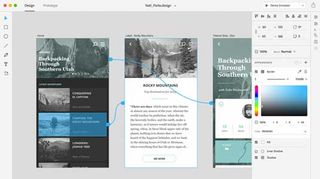9 tech trends that will change web design
Tom Moran, Gary Glozier and Sion Evans of TH_NK reveal their predictions for the coming year.
2016 is nearly here, but what will it bring the world of web design? Here the creatives at digital transformation agency TH_NK give their predictions.
Senior experience designer Tom Moran (1-3), design director Gary Glozier (4-6) and lead front end developer Sion Evans (7-9) have all dusted off their crystal balls.
But are they right? We'd love to know your thoughts, and your own predictions for the year ahead – please feel free to share them in the comments at the bottom.
01. Chat as Interface will change customer behaviour

As technology has evolved, communicating via conversation has grown with us; from typewriters, to telephones, to text messages to instant messenger. This year saw messenger apps (such as WhatsApp) overtake social media in popularity by a wide margin. The huge increase in popularity of messenger apps suggests a huge opportunity for businesses to rethink the user interface they currently use.
Still in its infancy, chat as interface is quickly becoming the wild west of opportunity as businesses realise the potential in combining ecommerce, customer service and social networking into one.
Next year will see a huge spike in chat interfaces being used for a wide variety of things. Powered by bots, AI or human operators we'll see traditional services replaced with a simple single conversational thread.
This is a huge shift in behaviour as customers become empowered with the ability to demand a service based on their terms and needs and not what a business wants to sell and how they want to sell it.
Initially, it's likely that various brands or apps will trial the chat interface approach for their digital service. However, in time we could see these individual chat clients becoming amalgamated into an overall operating system such as Siri.
This has huge implications for businesses as they will quickly become measured by the quality of service they are providing and not the impact of their branding or website.
02. Machine learning will take off
With the launch of TensorFlow and other similar open-source programmes, machine learning will quickly become the backbone of our digital world. Machine learning can be used for a huge variety of purposes, from learning about how you talk to the layout of a website.

Multivariant testing powered by machine learning will be able to automatically test and optimize a website at a customer level; meaning each customer sees a website specifically designed and tailored for them, from the language used to the layout of the page.
03. Customer experience will eclipse user experience
An internet-of-things, wearable devices and shifting customer behaviours have meant we can no longer think of a website or app in isolation from the entire customer experience.
As UX designers we have to 'zoom out' from our page level UI and follow a journey that starts at awareness and aims for lifetime customer value. We have to see the big picture and how all the digital tools at our disposal can be utilized to create a digitally rich customer experience.
At TH_NK we're already looking ahead for new approaches and methodologies for planning a customer experience. Experience mapping is an excellent methodology for visualizing large amounts of data and user needs, and we've already adopted this approach using it from checkout experiences to lifetime customer value cycles. In time, Experience Mapping could be the backbone for all our projects as it's flexible, customizable and highly scalable.
Changing how we perceive user journeys to Jobs to be Done will create a broader customer experience that focuses on customer needs and not page level features and interactions.
04. Retailers will embrace the connected consumer

We're an increasingly connected bunch. Smartphones are now in the pockets of two thirds (66%) of UK adults, the vast majority (90%) of 16-24 year olds and 50% of 55-64 year olds. Yet retailers have been slow to bridge the digital and physical shopping experience.
Beacons offer a route in. They give retailers the opportunity to personalise a shopping experience by providing rich information about products, push discounts to customers within range of a beacon or even give instructions on where in the store to find a product.
By arming its sales team with iPads that show customer purchase history and incorporating mirrors that double as digital displays Burberry have offered us a glimpse into how digital can transform the physical shopping experience. But that was in 2012. We're living in the internet of things and 2016 is the year we'll increasingly see high street brands offer interactive experiences in their stores.
05. Adobe Comet will put Sketch in the shade
In 2015 our design teams embraced Sketch; a design package that seems at home in the world of responsive design. The software proved to be a natural transition for all of our UI & UX designers. But looking forward into 2016, we're not confident that Sketch will remain our first choice. It's a Mac-only application which immediately cuts out the Windows users in the agency.

So we were delighted to learn that Adobe has finally filled the gap left by Fireworks with a design package called Project Comet. Assuming it can match or better the design workflow of Sketch, it could be the perfect accompaniment to Photoshop and quickly become our go-to tool for UX & UI design.
06. Video will continue to grow as a social medium
With the rise of platforms like Snapchat, Vine and Instagram, video as a marketing medium is continuing to grow in popularity. Production costs have fallen significantly and with 23.6 million 4G subscriptions in the UK in 2014 there's a growing audience able to consume video on the move.
The medium becomes even more appealing when you consider the appetite for video amongst millennials; In 2013 1 in 3 millennials watched mostly online video and no broadcast TV at all. By 2030 millennials will comprise 75% of the global workforce, making it hard to ignore platforms that resonate so well with this immense audience. Add to that Cisco's forecast that by 2017, video will account for 69% of all consumer internet traffic then the reasons for not taking the medium seriously become difficult to ignore.
Gadgets will always be a momentary source of fun. Maybe we're a little too eager to find the next office toy. As designers, we should take a step back, sharpen our styluses and concentrate on creating compelling experiences that make the most of the technology available.
07. ES6 will expand JavaScript functionality

JavaScript's 6th edition of the ECMAScript standard, ES6, has been in development for a few years now. Although browsers are still implementing new features, and full compatibility is not likely until mid-2016, transpilers like Babel and Traceur allow developers to start using new features today. Transpilers are source to source compilers, in this example they take ES6 code and create web-friendly ES5 code (the current standard).
It's unlikely this new implementation will see any performance benefits, but its cleaner, simpler syntax should become easier and less error prone to write. The new Class definition illustrates this, where ES5 already has prototypal inheritance, and does pretty much the same thing; it's just that ES6 makes it cleaner and easier to read.
There are a number of useful new features though – like functions, block-scoped constructs and promises, but nothing really ground-breaking. We'll have to wait for ES7 for that.
08. Isomorphic JavaScript: the same code for front and back end
Coined by Spike Brehm from AirBnb, Isomorphic JavaScript runs both client side and server side. The recent rise in the MV* frameworks hasn't come without its issues; apps that only run on the client side can't serve HTML to crawlers, so you instantly lose any SEO by default. Also, waiting for JavaScript to render the HTML impacts performance, leading to those annoying couple of seconds of blank screen during load.

Isomorphic JavaScript frameworks looks to be the next step in the evolution of MV* frameworks. These new libraries, Meteor, Render, and even Angular2 reportedly, are looking to solve some of these problems, and it's unlikely over the next few years that you'll find a server that isn't running some form of JavaScript somewhere.
09. HTTP/2 will give the net a boost
Everyone's seen HTTP in their browser bar, that bit at the start of the URL. It stands for Hypertext Transfer Protocol, and the current version HTTP/1.1 has been kicking around since 1999. 2016 will see more people switching to its newest incarnation, HTTP/2. It looks to improve the way browsers talk to servers, meaning quicker transfer of information, from lower bandwidth and less server load.
From a user's point of view nothing will change. You won't see http2:// in your browser bar, so in theory it will look as if nothing has changed. Except, of course, browsing speeds should improve. LoadImpact, a Devops performance company, ran some comparison tests between HTTP/1.1 and HTTP/2 using Amazon as the test site.
Results showed around 60% reduced load time using the new protocol. The performance improvements come from number of changes, multiplexing to interleave multiple messages at the same time. Header compression to reduce bandwidth, and the need for fewer connections reduce server load.
This is exciting stuff for all web developers, with improved load times and speeds, we'll see higher resolution images and videos, and more advanced apps across all devices.
Words: Tom Moran (1-3), Gary Glozier (4-6) and Sion Evans (7-9)
Tom Moran, Gary Glozier and Sion Evans are, respectively, senior experience designer, design director and lead front end developer at digital transformation agency TH_NK.
Liked this? Read these!

Thank you for reading 5 articles this month* Join now for unlimited access
Enjoy your first month for just £1 / $1 / €1
*Read 5 free articles per month without a subscription

Join now for unlimited access
Try first month for just £1 / $1 / €1
Get the Creative Bloq Newsletter
Daily design news, reviews, how-tos and more, as picked by the editors.
The Creative Bloq team is made up of a group of design fans, and has changed and evolved since Creative Bloq began back in 2012. The current website team consists of eight full-time members of staff: Editor Georgia Coggan, Deputy Editor Rosie Hilder, Ecommerce Editor Beren Neale, Senior News Editor Daniel Piper, Editor, Digital Art and 3D Ian Dean, Tech Reviews Editor Erlingur Einarsson and Ecommerce Writer Beth Nicholls and Staff Writer Natalie Fear, as well as a roster of freelancers from around the world. The 3D World and ImagineFX magazine teams also pitch in, ensuring that content from 3D World and ImagineFX is represented on Creative Bloq.
